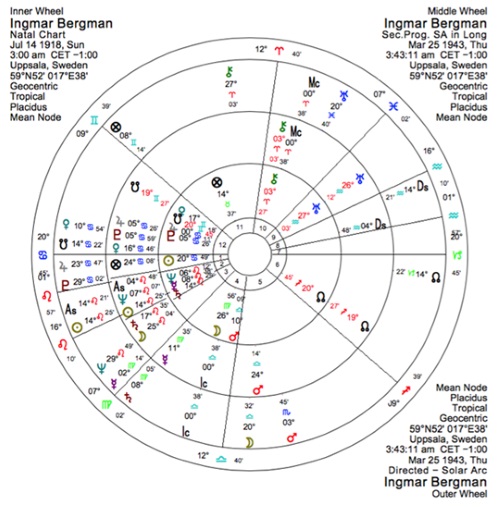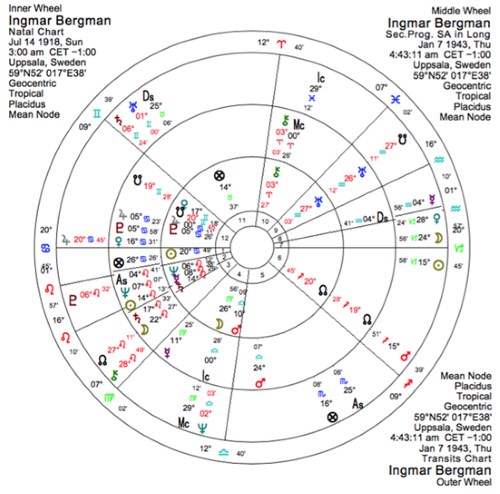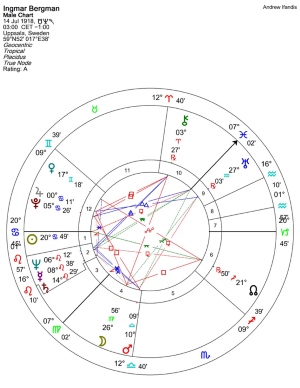By: Andrew Ifandis
Ingmar Bergman, the celebrated Swedish film and stage director/writer was one of the most influential auteurs of our age. His artistic explorations of death, illness, faith, betrayal and insanity reflected his own preoccupations. This hyper-sensitive and volatile man also led a tempestuous love life and fathered many children while seeking seclusion. How is all this reflected in his nativity?
It is just after dawn, a barren rocky shore. The sea is colourless beneath the grey and empty sky. We hear the splash of the waves. In the fore of the frame a knight is playing chess with Death.
 This is one of the most iconic scenes in the history of Cinema, from the film The Seventh Seal by Ingmar Bergman, in which the main character, a Knight (played by Max von Sydow) having just returned from the Crusades, is meditating on the meaning of life and the existence of God.
This is one of the most iconic scenes in the history of Cinema, from the film The Seventh Seal by Ingmar Bergman, in which the main character, a Knight (played by Max von Sydow) having just returned from the Crusades, is meditating on the meaning of life and the existence of God.
The Seventh Seal, released in 1957, is a classic masterpiece that established him as a great director. Bergman made seventy-seven films between 1944 and 2003, exploring in depth the human condition. Central motifs and themes of his work embrace existential anguish, fear of death, the hell of marriage, the failure to establish meaningful contact in human relations, the redemptive power of art, the happiness found in the simplest things in life and the return to childhood.
Prolific and tireless, he wrote the majority of the scripts of his films, authored two autobiographies and three novels; and besides being a movie director, he was also an equally remarkable theatre/TV/radio director, staging a total of 171 productions in a period spanning nearly sixty years.
Ingmar Bergman was a passionate person both in his art and in his private life. He married five times, had numerous mistresses and fathered a total of nine children. Among his ‘secret’ affairs, three were with his leading actresses and one with a Swedish countess with whom he had a child – a fact that was only made public forty-five years later! (1)
His artistic legacy is huge. He is considered by many to be among the world’s greatest film and theatre directors. His personal archives are preserved by UNESCO and considered to be part of the world’s heritage.(2)
Ingmar Bergman’s Natal Chart
Bergman was born on 14 July 1918, in Uppsala, Sweden, at 3 am, a time that he himself mentions in his autobiographical novel Sunday’s Child.(3) The study of his natal chart is very revealing. (Click on the chart for a full size image.)
His Sun is in Cancer conjunct Cancer Ascendant. This placement enhances Cancerian traits and ensures that a strong impression is left on others – he would always be regarded as a natural leader who inspires. In his television interviews you soon become aware (from the tone of his voice and overall manner) of his immense sensitivity and warmth. His performers considered him to be a deeply intuitive director, extremely sensitive to moods and emotions (Cancer). He stated numerous times in his writings that the essence of his creativity is made up of intuition, childhood and dreams. “I was very dreamy in my childhood, sometimes mixing reality with dreams.” (4)
His memory (with Moon disposited by Mercury and Mercury conjunct Neptune) was photographic – or to say it more fittingly, cinematic. He recalled his first memories from the age of two: “The house smelt of new paint and polished parquet flooring. The nursery had sun-yellow linoleum on the floor and light-coloured blinds with castles and meadow flowers on them,” he wrote in his autobiography.(5)
 His Moon, dispositor of his Cancer Sun, ruler of Ascendant and therefore chart ruler, and positioned in the 4th house [traditional domain of Cancer] is indicative of his deep emotional contact with the past, his need to return to the womb of childhood, and of his profound connection with his mother whom he loved immensely. His film Karin’s Face consists of still photo images of his mother.
His Moon, dispositor of his Cancer Sun, ruler of Ascendant and therefore chart ruler, and positioned in the 4th house [traditional domain of Cancer] is indicative of his deep emotional contact with the past, his need to return to the womb of childhood, and of his profound connection with his mother whom he loved immensely. His film Karin’s Face consists of still photo images of his mother.
In another expression of his maternal and protective qualities (Moon) he took care of his actors. Always caring, he retained a close troupe of select people with whom he constantly worked. Over the years he called his actors “my family”.
His Moon is located in Virgo, disposited by Mercury in Leo and square Jupiter. This combination urged him to seek emotional balance through his work. He approached direction with attention to the smallest detail: theatre rehearsals were meticulously and punctually organised, and held at the same time every day.
Virgo Moon, typically, also gave him chronic digestion problems and a nervous stomach; he was extremely sensitive to emotional stress. Bergman wrote:
I have always suffered from what is called a nervous stomach, a calamity as foolish as it is humiliating. With a never-ebbing and often sophisticated wealth of invention, my bowels have sabotaged my efforts. The attack comes like lightning and without warning and the pain is hard to endure. (6)
Mercury and Saturn conjunct in Leo in the 2nd house bestowed organisational thinking and an authoritative expression, elements necessary for a director who must manage, among other thing, tricky human resources and financial budgets.
This Saturn-Mercury conjunction has another, much deeper meaning: Saturn darkens the creative mind with phobias, demons, anxiety and existential anguish, themes (as already touched on) of all his films. Let’s not forget that Mercury is ruler of his 12th house (fears, the unconscious, the unseen); and Saturn oversees his 7th house (relationships): both planets are in Leo, so that the creativity of Bergman’s mind is expressed through dramatic and theatrical media (Leo), with topics relating to the metaphysical quest (12th house) and the hellish difficulties that relationships and marriage (7th house) can present.
Such themes are explored in his oeuvre, such as in his ‘Silence of God’ trilogy (Through a Glass Darkly, Winter Light).
Neptune, planet of both the collective unconscious and of Cinema, is in a tight conjunction with Mercury. Neptune thus becomes a personal planet bestowing creativity and imagination to Bergman’s mind; and through Leo gives a talent not only for the Cinema but for theatre and dramaturgy. Bergman started directing stage plays early on in life when at university and was director of various theatres; most notably, Director of the Royal Dramatic Theatre in Stockholm for many decades.
Neptune connotes dreams and images, and in Bergman’s chart, these are linked to career (10th house) and the sign it rules, Pisces – on which his Midheaven is found. Through the Mercury conjunction, dreams and images become words, words become movies and stage plays, fears are exorcised through art, and art brings him international recognition, fame status and prestige!
Bergman’s great success and achievements are shown clearly in the chart from the Jupiter-Pluto conjunction in the 12th house. This is a classic aspect that offers success to anyone who passionately and wholeheartedly devotes himself to his big ideal.
In Bergman’s case, this conjunction is further aided by the semi-sextile that Pluto makes to Neptune, between the 12th and the 2nd house, stimulating the planets’ energies for success through art, Cinema (Neptune = art and illusions), which deals with the unconscious and metaphysical (12th house) and brings economic rewards (2nd house) through creative expression (Leo).
Jupiter, exalted in Cancer, plays an even more important role in the manifestation of his success, positioned on a critical degree (a Sun’s degree that denotes wilful realisation of one’s being) at 0°12’ of Cancer. What more could anyone want than to have a Pluto empowered Jupiter placed in the same sign as his Sun and Ascendant and on a degree that relates to completion of being and ambition? Further to this, Pluto’s trine to Midheaven contributes to achievements in the chosen profession and to great fame.
 Persona, shot in 1965, is still considered today to be one of the most representative works of modern art (not just of Cinema but also of the arts in general) and it is Bergman’s crowning achievement, “one of the previous century’s great works of art”.(7)
Persona, shot in 1965, is still considered today to be one of the most representative works of modern art (not just of Cinema but also of the arts in general) and it is Bergman’s crowning achievement, “one of the previous century’s great works of art”.(7)
The film’s ingenious modernity, its ambivalence, its deep complexity, its psycho-analytical approach, the alchemical process of merging identities, and the sheer intensity that the film resonates with, are archetypical Uranus-Pluto energies. Please let me note at this point that Bergman made very personal films that were a means to his own self – a form of psychoanalysis – and so the archetypal energies to be found in the movie reveal crucial elements of his own psychology and personality.
Uranus is very important in Bergman’s chart because it’s the focus point in a Sling planetary pattern, collecting the energy from all the other planets placed in the eastern hemisphere, infusing it with his unique individuality. Uranus also rules the 8th house of probing psychology and takes on much of the Plutonian energy of the house.
Pluto in the 12th house speaks of obsession with the idea of death and the hereafter, something that characterised Bergman from his early childhood, until well after his fiftieth year, when he finally managed to overcome this apprehension. Pluto is also the ruler of Scorpio, an important sign intercepted within the 5th house, and this rulership, combined with Jupiter’s conjunction, gives abundance, and is surely a natal promise of many children.
Jupiter square Moon is another interesting aspect: it made him rather hyper-sensitive and over-reactive to situations, especially when he felt hurt. A very characteristic example of this was when in January 1976 he was unjustly accused by the Swedish state of tax evasion. Bergman was so shocked that he was hospitalised at a mental hospital for six months, and afterwards he left Sweden in protest, staying in self-exile in Germany for eight years.
His Venus in Gemini in the 12th house speaks eloquently of his numerous secret love affairs, as well as denoting his “aesthetic of the unconscious” and psychoanalytical approach to films.
Finally, a rather bold stroke in the canvas of his chart: the Mars-Pluto square conceals uncontrolled sexual passion, outbursts of violence and frustrating anger. Bergman, as we’ve seen, was an extremely caring and sensitive person; but he was also called a “demonic” director by many of his collaborators and lovers because in his rages he lost self-control.
He (Bergman) was desperate to find out why he was so tense and full with anger that Liv [Ullmann, his lover] at times had to escape from him in fear of her life.(8)
Bergman was wise enough to try and conquer his demons through his art.
The demons are innumerable, arrive at the most inappropriate times and create panic and terror, but I have learned that if I can master the negative forces and harness them to my chariot, then they can work to my advantage. The trick is to create some beauty out of the ugliness. (10)
In her book, The Persona of Ingmar Bergman, Barbara Young, a psychiatrist and Bergman scholar, concludes:
“What makes Bergman unique is that he conquered his demons through his creativity. With no help from a psychiatrist –through intuition and a floating imagination – Bergman faced down his demons, overcoming his terror of death, gaining control over his murderous rage and solving his problem with intimacy, which had led to his abandonment of four wives, eight children and many mistresses.”
As we have seen through the analysis of his natal chart, Bergman was a deeply intuitive and creative artist. He could be both sensitive/caring and cruel/authoritarian/demanding. Through his art, he expressed his natal potential and achieved fame and success, using his fears and existential anxieties as the basis of hard and meticulous work.
Ingmar Bergman’s life is illustrative of how a person can work on the difficult aspects of a chart and exploit their dynamic in combination with the harmonious ones.
He died on 30 July 2007. His art lives on.
Transits, Secondary Progressions and Solar Arc Directions during key events of his life
Ingmar Bergman’s first marriage (25 March 1943)

Aspects
1. His progressed Saturn (ruler of the 7th house of marriage) is sextile to his natal Venus.
2. His progressed Sun is conjunct his natal Saturn (ruler of the 7th house of marriage).
3. His progressed Moon is conjunct his natal Sun/Moon midpoint.
4. His solar arc Venus is square to his Natal Mars.
5. His progressed Sun Moon midpoint is square to his natal Venus.
We see here a series of classic wedding aspects involving the ruler of the 7th, Venus, Sun and the Sun/Moon midpoint. The squares that Venus makes in the last two aspects are suggestive of the difficulties that will be present in the marriage. Within two years of this first wedding, Bergman had divorced and remarried.
His first Job in Svensk Filmindustry (January 1943)
Bergman got a job in the scripts section of Svensk Filmindustry, marking the beginning of his cinematic career. Very quickly his first script was accepted and turned into a film. Then the next year, he directed his first film, Crisis.

Aspects
His transiting Jupiter is conjunct natal Ascendant, and most importantly, his progressed Midheaven is on the Aries Point, denoting the start of his career with opportunity for public recognition.
Shooting of Persona: July to September 1965
Bergman filmed Persona on the remote island of Faro. During the shoot he started an affair with Liv Ullmann, his lead actress. He was so in love with her and he so much liked the isolation of the island, that he decided to build a house there, so that he and and Ullmann could live together – which they did for several years. Bergman stayed on in this house to his death.

Aspects
1. His progressed Ascendant is sextile his natal Venus and also square transiting Neptune. (He outwardly expresses his romantic feelings, and he is also expressing aesthetically (Venus) through the medium of film (Neptune.)
2. His progressed Sun is sextile his natal Pluto. (The shooting of the film is a transformative experience; a new place to live and a new woman to live with.)
3. His transiting Jupiter is trine progressed and natal Uranus. (Change through success. Modernity in his creation.)
Endnotes:
(1) BBC News, 19 October 2004, Bergman reveals secret love child.
http://news.bbc.co.uk/2/hi/entertainment/3755384.stm
(2) Variety, 27 June 2007, UNESCO to preserve Bergman Archives.
http://variety.com/2007/film/news/unesco-to-preserve-bergman-archives-1117967760/
(3) Astro Databank, Ingmar Bergman birth chart.
http://www.astro.com/astro-databank/Bergman,_Ingmar
Sunday’s Child, page 44 of English translation, by Joan Tate.
(4) A Conversation with Ingmar Bergman: Director Ingmar Bergman appears on The Dick Cavett Show in an interview that originally aired August 2, 1971.
http://filmmakeriq.com/2013/03/a-conversation-with-ingmar-bergman/
(5) Ingmar Bergman, The Magic Lantern, Penguin Books, Joan Tate translation, page 2.
(6) Ingmar Bergman, The Magic Lantern, Penguin Books, Joan Tate translation, page 62.
(7) Hubert Cohen, Ingmar Bergman: The Art of Confession, New York: Twayne, 1993, page 227. Susan Sontag even claimed that Persona was the best film ever.
(8) Barbara Young, The Persona of Ingmar Bergman: Conquering Demons through Film, Rowman & Littlefield, 2015, page 142.
(9) The Guardian, 12 December 2001, Bergman talks of his dreams and demons in rare interview.
http://www.theguardian.com/film/2001/dec/12/news.xanbrooks
© 2016 Andrew Ifandis – first published by The Astrological Journal, Jul/Aug 2016 / The Astrological Association of Great Britain. Reprinted here by permission of the author.
Biographical Notes:
{article title=”Ifandis, Andrew”}{text}{/article}
Image Credits (from Wikimedia)
- Top: Ingmar Bergman (1918–2007), Swedish stage and film director. Photo: Taken during the production of Wild Strawberries (Smultronstället) (1957). Source: Svenska filministitutet. Author: Louis Huch (1896–1961), at SF 1930–60
- Bengt Ekeroth and Max von Sydow in The Seventh Seal, 1957. © Svensk Filmindustri, Ingmar Bergman (director), Gunnar Fischer (cinematographer)
- Picture of young Ingmar Bergman from Wikipedia Images, Author: Pressens Bild. Source: http://sydsvenskan.se/kultur-och-nojen/article255167/Scener-ur-fem-aktenskap.html
- Movie poster from Persona




